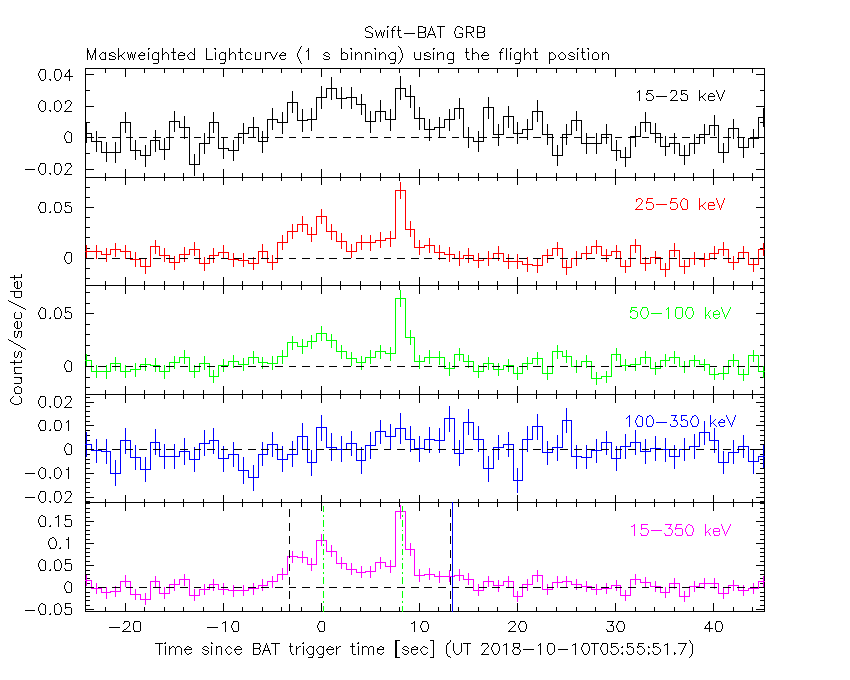
A. Melandri (INAF-OAB), P.A. Evans (U. Leicester) and S.W.K. Emery (UCL-MSSL) for the Swift team
At 05:55:51 UT, the Swift Burst Alert Telescope (BAT) triggered and located GRB 181010A (trigger=866434) (Melandri et al. GCN Circ. 23309). Swift slewed immediately to the burst. At the time of the trigger, the initial BAT position was 133° from the Sun (9.5 hours West) and 143° from the 2%-illuminated Moon. Table 1 contains the best reported positions from Swift, and the latest XRT position can be viewed at http://www.swift.ac.uk/xrt_positions.
Melandri et al. (GCN Circ. 23309) reported the discovery with UVOT of an optical afterglow. J-B. Vielfaure et al. (GCN Circ. 23315) determined a redshift of 1.39 from VLT. Table 2 is a summary of GCN Circulars about this GRB from observatories other than Swift.
Standard analysis products for this burst are available at https://gcn.gsfc.nasa.gov/swift_gnd_ana.html.
As reported by Lien et al. (GCN Circ. 23321),
the BAT ground-calculated position is RA, Dec = 52.574, -23.023 deg, which is RA(J2000) = 0
The mask-weighted light curve (Figure 1) shows several overlapping peaks starting at ~T-5s, peaking at ~T+8 s, and returning to baseline at ~T+15 s.
The time-averaged spectrum from T-4.04 to T+15.21 s is best fit by a simple power-law model.
The power law index of the time-averaged spectrum is 1.52 ± 0.15.
The fluence in the 15-150 keV band is 6.9 ± 0.7 x 1
The results of the batgrbproduct analysis are available at https://gcn.gsfc.nasa.gov/notices_s/866434/BA/.
Analysis of the initial XRT data was reported by Evans et al. (GCN Circ. 23316). We have analysed 19 ks of XRT data for GRB 181010A, from 77 s to 126.7 ks after the BAT trigger. The data comprise 77 s in Windowed Timing (WT) mode (the first 9 s were taken while Swift was slewing) with the remainder in Photon Counting (PC) mode. The enhanced XRT position for this burst was given by Evans et al. (GCN Circ. 23313).
The light curve (Figure 2) can be modelled with a series of power-law decays. The initial decay index is α=8.0 (+0.0, -3.1). At T+86.5 s the decay flattens to an α of 0.738 ± 0.021. The light curve breaks again at T+11.9 ks to a decay with α=3.7 (+2.6, -0.7), and again at T+16.5 ks s to α=-1.5 (+0.0, -0.7), before a final break at T+22.4 ks s after which the decay index is 1.06 (+0.21, -0.18).
A spectrum formed from the PC mode data can be fitted with an absorbed power-law with a photon spectral index of 1.79 (+0.09, -0.08). The best-fitting absorption column is 2.00 (+0.32, -0.29) x 1
A summary of the PC-mode spectrum is thus:
Galactic foreground: 1.9 x 1
Intrinsic column: 2.00 (+0.32, -0.29) x 1
Photon index: 1.79 (+0.09, -0.08)
The results of the XRT team automatic analysis are available at http://www.swift.ac.uk/xrt_products/00866434.
The Swift/UVOT began settled observations of the field of GRB 181010A 96 s after the BAT trigger
(Emery and Melandri GCN Circ. 23317).
A source consistent with the XRT position (Evans et al. GCN Circ. 23313) is detected in the initial UVOT exposures.
Table 3 gives preliminary
magnitudes using the UVOT photometric system
(Breeveld et al. 2011, AIP Conf. Proc., 1358, 373).
No correction has been made for the expected extinction in the Milky Way
corresponding to a reddening of

Figure 1. The BAT
mask-weighted light curve in the four individual and total
energy bands. The units are counts

Figure 2. The XRT light curve.
Any data from a crosshatched region are not included in the fit.
| RA (J2000) | Dec (J2000) | Error | Note | Reference |
|---|---|---|---|---|
| 0 |
-23°02'15.4" | 0.49" | UVOT-refined | Emery and Melandri GCN Circ. 23317 |
| 0 |
-23°02'16.6" | 1.4" | XRT-final | UKSSDC |
| 0 |
-23°02'18.4" | 1.8" | XRT-enhanced | Evans et al. GCN Circ. 23313 |
| 0 |
-23°01'22.7" | 1.4' | BAT-refined | Lien et al. GCN Circ. 23321 |
| Band | Authors | GCN Circ. | Subject | Observatory | Notes |
|---|---|---|---|---|---|
| Optical | Gorbovskoy et al. | 23310 | MASTER-Argentina OT detection | MASTER | detection |
| Optical | Martone et al. | 23311 | LCO Cerro Tololo observations | LCO | detection |
| Optical | Troja et al. | 23312 | RATIR Optical and NIR Afterglow Detection |
RATIR | detection |
| Optical | J-B. Vielfaure et al. | 23315 | VLT/X-shooter redshift | VLT | redshift |
| Optical | Reynolds et al. | 23319 | ePESSTO NTT optical observations | PESSTO | detection |
| Optical | D'Avanzo et al. | 23323 | REM optical and NIR afterglow detection | REM | detection |
| Optical | Schady and Bolmer | 23326 | GROND afterglow detection | GROND | detection |
| Gamma-ray | von Kienlin | 23320 | Fermi GBM observation | Fermi GBM | Fluence=6.13±0.98x1 ( |
| Filter | Exp(s) | Mag | ||
|---|---|---|---|---|
| whit |
96 | 246 | 147 | 19.42 ± 0.09 |
| white | 589 | 6359 | 247 | >21.0 |
| v | 3867 | 5503 | 393 | >19.4 |
| b | 564 | 6323 | 413 | >20.9 |
| u | 309 | 6117 | 639 | >20.6 |
| uvw1 | 4277 | 5912 | 393 | >20.1 |
| uvm2 | 4072 | 5707 | 393 | >20.7 |
| uvw2 | 5098 | 5298 | 197 | >20.5 |
Table 3. UVOT observations reported by Emery and Melandri (GCN Circ. 23317). The start and stop times of the exposures are given in seconds since the BAT trigger. The preliminary detections and 3-σ upper limits are given. No correction has been made for extinction in the Milky Way.
October 12, 2018